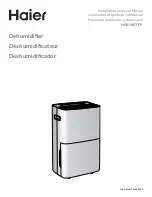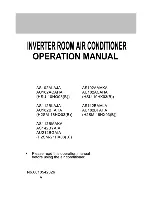
16
6
F
2
S
0
7
8
9
2.3.4 Setting
The following shows the setting elements necessary for the current differential protection and
their setting ranges. The setting can be performed on the LCD screen or PC screen.
Element
Range
Step
Default
Remarks
DIFT
DIF
ik
0.10
1.00
(
)
0.01
0.30
Minimum operating current
p1
10
100%
1%
100%
% slope of small current region
p2
10
200%
1%
200%
% slope of large current region
kp
1.00
20.00(*)
0.01
1.00
Break point of dual characteristics
k2f
10
50%
1%
15%
Second harmonic detection
k5f
10
100%
1%
30%
Fifth harmonic detection
HOC
kh
2.00
20.00(*)
0.01
2.00
High-set overcurrent protection
CT matching
kct1 0.05
50.00
0.01
1.00
Primary winding
CT ratio
kct2 0.05
50.00
0.01
1.00
Secondary winding
kct3 0.05
50.00
0.01
1.00
Tertiary winding
d1
0
11
1
0
Primary winding
Phase angle
d2
0
11
1
0
Secondary winding
d3
0
11
1
0
Tertiary winding
Scheme switch
Enable or disable to
[DIFTPMD]
3POR / 2PAND
3POR
Trip mode
[2F – LOCK]
Off / On
On
block by second harmonic
[5F - LOCK]
Off / On
On
block by fifth harmonic
[DIF1] to [DIF5]
Off / On
(**)
output tripping signal
(
): Multiplier of CT secondary rated current including CT ratio sorrection.
(**): Default settings are dependent on the models. See Appendix H.
Setting of ik
ik determines minimum operation sensitivity of DIF element. ik is set as a ratio to the CT
secondary rated current.
Minimum setting of ik is determined from the maximum erroneous differential current under
normal operating conditions.
Setting of p1, p2 and kp
Percentage restraining factor (% slope)
= (Differential current) / (Through current)
= (Differential current) / [{(Incoming current) + (Outgoing current)} /2]
p1 is the percentage restraining factor which defines the DIF restraining characteristic in the
small current region. The setting is determined by the sum of:
Summary of Contents for GRT100 Series
Page 142: ... 141 6 F 2 S 0 7 8 9 Appendix A Block Diagram ...
Page 144: ... 143 6 F 2 S 0 7 8 9 Appendix B Signal List ...
Page 159: ... 158 6 F 2 S 0 7 8 9 ...
Page 160: ... 159 6 F 2 S 0 7 8 9 Appendix C Variable Timer List ...
Page 162: ... 161 6 F 2 S 0 7 8 9 Appendix D Binary Output Default Setting List ...
Page 165: ... 164 6 F 2 S 0 7 8 9 ...
Page 166: ... 165 6 F 2 S 0 7 8 9 Appendix E Details of Relay Menu and LCD and Button Operation ...
Page 174: ... 173 6 F 2 S 0 7 8 9 Appendix F Case Outline Flush Mount Type Rack Mount Type ...
Page 179: ... 178 6 F 2 S 0 7 8 9 ...
Page 180: ... 179 6 F 2 S 0 7 8 9 Appendix G External Connections ...
Page 185: ... 184 6 F 2 S 0 7 8 9 ...
Page 200: ... 199 6 F 2 S 0 7 8 9 ...
Page 201: ... 200 6 F 2 S 0 7 8 9 Appendix J Return Repair Form ...
Page 205: ... 204 6 F 2 S 0 7 8 9 Customer Name Company Name Address Telephone No Facsimile No Signature ...
Page 206: ... 205 6 F 2 S 0 7 8 9 ...
Page 207: ... 206 6 F 2 S 0 7 8 9 Appendix K Technical Data ...
Page 220: ... 219 6 F 2 S 0 7 8 9 ...
Page 221: ... 220 6 F 2 S 0 7 8 9 Appendix M Symbols Used in Scheme Logic ...
Page 224: ... 223 6 F 2 S 0 7 8 9 ...
Page 225: ... 224 6 F 2 S 0 7 8 9 Appendix N Implementation of Thermal Model to IEC60255 8 ...
Page 228: ... 227 6 F 2 S 0 7 8 9 ...
Page 229: ... 228 6 F 2 S 0 7 8 9 Appendix O IEC60870 5 103 Interoperability and Troubleshooting ...
Page 241: ... 240 6 F 2 S 0 7 8 9 Appendix P Modbus Interoperability ...
Page 255: ... 254 6 F 2 S 0 7 8 9 ...
Page 256: ... 255 6 F 2 S 0 7 8 9 Appendix Q Inverse Time Characteristics ...
Page 259: ... 258 6 F 2 S 0 7 8 9 ...
Page 260: ... 259 6 F 2 S 0 7 8 9 Appendix R Failed Module Tracing and Replacement ...
Page 266: ... 265 6 F 2 S 0 7 8 9 Appendix S Ordering ...
Page 269: ... 268 6 F 2 S 0 7 8 9 3 1 Oct 2 2017 Republished under spin off company ...
Page 270: ......
















































